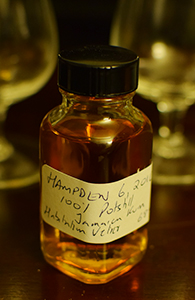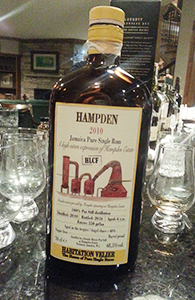
Rum was my drink of choice in my college and post-college years in India. That’s largely because rum was the only decent spirit available in India in those days. Indian whisky was not worth talking about, unless you managed to get your hands on a bottle of Solan No. 1 (which was hard to get even in the late 1980s)—even as a callow teenager I knew that all those whiskies were largely good for was getting drunk, and even then you’d have to mix them with a lot of soda. There were some decent rums though—Old Monk, for example. Truth be told, we drank Old Monk largely with coke as well but it did not punish you if you drank it neat or with water. (Old Monk is still around and even available in the US as of a few years ago.) And not that I could afford very good taste when I came to the US as a graduate student in the early 1990s, but rums that were widely available then (or even now for that matter) weren’t very much better (either bland white rums or spiced monstrosities). Of late though the situation has begun to change as more esoteric rums from the Caribbean have begun to become available and rum is slowly making the transition from a cocktail ingredient to a sipper in its own right. It’s behind tequila and even mezcal in this regard but it’s getting there.
Now, I don’t want to pretend that I know very much about rum because I do not. I know nothing about regional/national variations or profiles and only a little bit about production methods. I can tell you, since I’ve looked it up, that Hampden, a Jamaican producer, is renowned for making rums that are very high in esters (in other words, extremely aromatic rums). My roughly patched together understanding is that such rums are actually made to be parts of recipes in other blended rums—and, in fact, if you look at Hampden’s website you’ll see that they even say that their rums are in high demand in the perfume and food industries. They don’t even list regular rum releases and it’s not clear to me what fraction of their output is actually mean for sipping and how much of it has ever been available outside Jamaica*. (If you poke around the website you’ll also come across their section on their history and if you know anything about the history of sugar plantations in the Caribbean you’ll feel more than a bit queasy.)
K&L in California have done a lot of good work in recent years in bringing Caribbean rums to the US and they’ve brought more than one Hampden in as well—I have a sample of one of those from Sku that I’ll probably review later this month. This Hampden, however, is bottled by Habitation Velier, an Italian concern that has begun to put out a series of potstill rums from individual distilleries, much in the manner of independently bottled Scottish single malts. These are devoid of additives and are bottled at cask strength (some, as in this case, at ludicrously high strengths). The prices are quite reasonable but they’re only available in Europe.
My friend Pat acquired a bottle and brought it with him to a tasting of peated whiskies in the Twin Cities in early December. Given the focus of the tasting, I didn’t taste it then but he generously poured me a large sample to take home. He did have a little bit poured for all of us to nose and man, it was a powerful nose. I’d been looking forward to tasting it and finally got around to it at the end of the month.
 Hampden 6, 2010 (68.5%; Jamaican pot still rum; from a sample from a friend)
Hampden 6, 2010 (68.5%; Jamaican pot still rum; from a sample from a friend)
Nose: High esters indeed! Bananas, bananas and more bananas; also, caramelized bananas and banana bread (with candied ginger, just like I make it). You can smell the strength too…There’s some toffee as well and light notes of apricot and marmalade and honey too. Along with the sticky, sweet fruity notes there’s also a mineral note—think very well oiled and maintained machinery. The oiliness and fruitiness increases with time. With water it moves even more in the direction of oiled machinery and there’s a strong note of putty and wax too now.
Palate: Big sticky fruit to start—almost Grand Marnier’ish. Surprisingly drinkable at full strength (very small sips). Quite syrupy on the second sip—in fact, I’d be tempted to drizzle this on buttered pancakes. That oily, minerally note from the nose shows up on the third sip and then starts showing up earlier and earlier. Okay, I should add some water before I get alcohol poisoning. Ah yes, water brings out even more of the oily machinery here as well and it’s less overbearingly, and stickily, fruity (though it’s still sticky and sweet). Some brine too now.
Finish: Long. As the fruit fades out a smokiness begins to arise. With water the sweetness from the palate seems to get pushed back to the finish—bananas again now—but the brine that showed up continues too.
Comments: Well, this is big in every possible way—I’ve never had anything quite like this. But while I really, really enjoyed this—especially the nose—I can’t see reaching for it very often if I had a bottle. While the oily, greased machinery notes are really interesting, the sweet/fruity side on the palate remains too sweet and one-dimensional—it’s almost like a supercharged liqueur, actually, on that front. Hmmm I might have a way to get a bottle, but do I want to do it?
Rating: 89 points. (In the 90s if scoring the nose alone.)
Thanks to Pat for the sample (though not so much for tempting me with a whole new category of spirits)!
*For more detail on the distillery, see here for a comprehensive account of a visit to it by a group of rum-aficionados.

Thanks for throwing a rum review into the mix. Can’t wait to see your notes on the new K & L. I have a bottle on the way.
I was able to try a sample of the Velier Hampden and our notes are pretty close(especially that candied ginger note). Hopefully Velier will continue to release these Jamaican rums as they age in place. Time brings much more depth to these rums.
LikeLike
The other K&L Hampden I have a sample of is not the new one—a 24 yo, right? It’s the earlier 14 yo released under the Faultline label. If I’d tasted this 6 yo before the new one sold out I would have bought a bottle but Sku’s rave review took care of that.
I may be mistaken but I think this 6 yo was distilled by the new owners/operators of the distillery—I’m not sure if there’s been any change in processes or if there’s a old Bruichladdich/new Bruichladdich kind of thing in play with the 24 yo vs. something like this 6 yo.
LikeLike
I bought a bottle of the 14 year(which was fantastic) which prompted me to buy a bottle of the 24 the day it came out. I’m honestly not sure how much continuity there has been in the operations of the distillery between new and old ownership.
I was also able to get samples of a second Velier Hampden and a Velier Worth Park which I am working through now.
LikeLike
Whoa MAO – I do like my rum, so now I have a reason to check this side of your blog!
I brought home a bottle of Old Sugar Distillery’s Cane and Abe while visiting my brother ‘s family in Madison, WI. It is delicious.
LikeLike
You can find Hampden-distilled rum in the US more commonly under the brands Smith & Cross (created for bartenders who wanted a 19th-Century style Jamaican rum for old recipes) and Mezan XO, one of the best values in rum.
LikeLike
Interesting—are these just Hampden rums with different branding or is anything else done to them before bottling?
LikeLike
I’ll second Smith & Cross, it’s easily one of the best readily available rums in the States right now. I keep hoping that others will seek to emulate the style and bring in more high-ester Jamaican rums, but so far it’s been pretty quiet. Also, while it’s been a while since I tried it, the Haus Alpenz Scarlet Ibis, which is sourced from Trinidad rather than Jamaica, is also excellent and a slightly less in-your-face style.
LikeLike
I see you reviewed Smith & Cross, Jordan. It does sound very good. And, unlike the Mezan XO, it appears to be available in the Twin Cities. I’m in for a bottle.
LikeLike
If you find yourself wanting to go deep, deep (deep!) down the rabbit hole, I would point you toward Boston Apothecary, who has many informative posts on the science of rum distillation — often based on quite old primary literature from the industry. It is, perhaps, too much information at times (i.e., he could use an editor), but illuminating nonetheless.
https://www.bostonapothecary.com/category/rum/
LikeLike
Thanks for that!
LikeLike
Simply one of best noses ever. Machine shop liquor notes are the reason to acquire.
LikeLike
Once we return to real single rums we will also need to be open to what traditional authentic tasting notes are as well as its effect on the nose and pallet. It’s like the yellow and taste we see with commercially grown bananas and commercial egg yolks. You literally have to go rediscover the taste of free range eggs. The same with real bananas.
I suspect that rums have been so blended and altered over the years that authentic single rums will take some time to get used to.
Now that we have GI and a move to regional/ original singles, we will be able to experience what the best of each region can produce. Similar to fine wine that is of the land and climate that it is cultivated.
Indeed, a new world of tastes and experiences.
LikeLike
Yes, and someone’s got to take a chance on the US as a market for these rums too. Perhaps there just isn’t enough of it being made to feed both the established European market and the US?
LikeLike